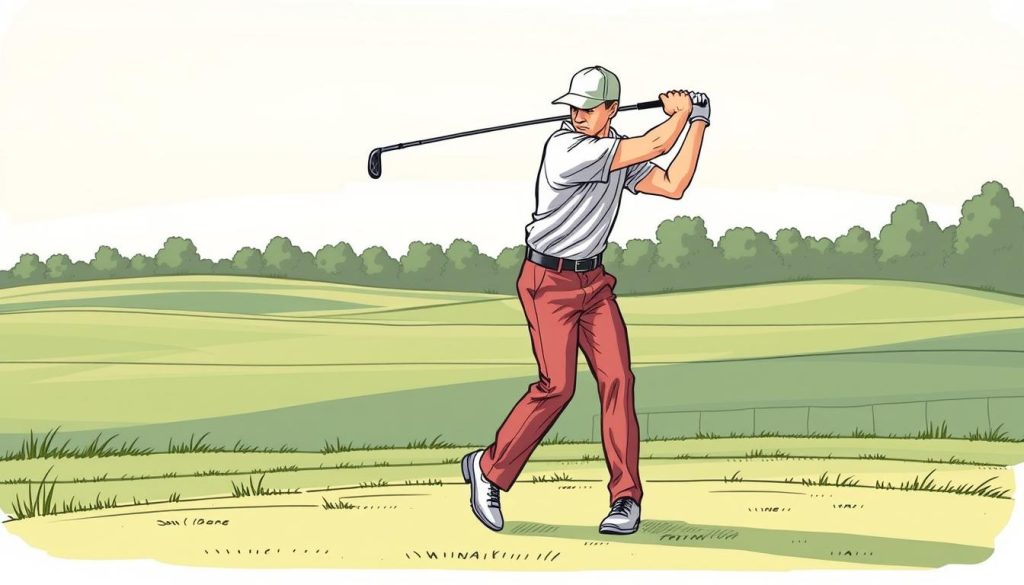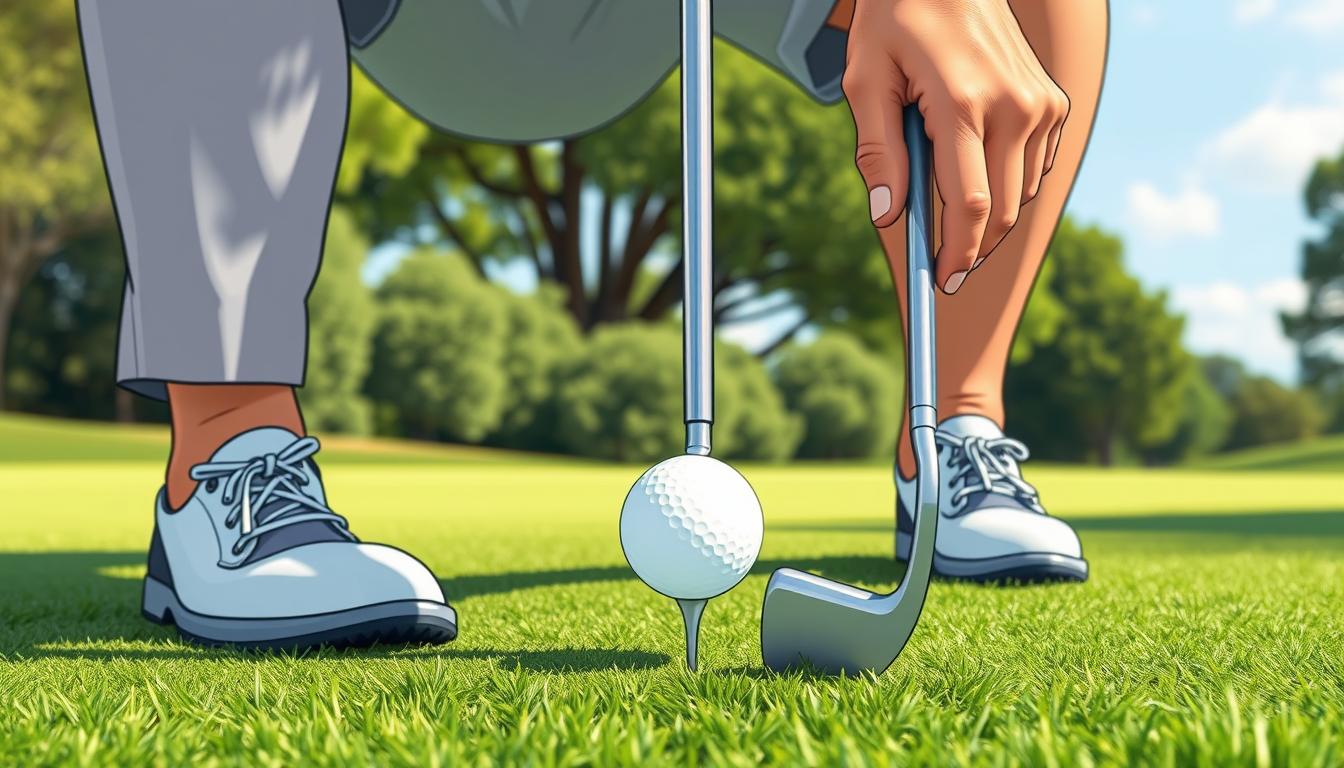Golf putting is all about precision and patience. This guide explores the biomechanics of golf swing, focusing on putting. You’ll learn how to improve your game with detailed analysis of your swing.
The perfect putt needs speed, aim, and stroke. PGA Tour pros make 75% of 5-foot putts and 95% of 3-foot putts. To get better, you must understand the biomechanics of a perfect stroke.
A consistent setup is key for a reliable stroke. Your chest should be level, eyes over the ball, and shoulders even. Using your deltoid muscles helps you aim better and keep the putter face square at impact.
Key Takeaways
- Putting requires a blend of technical skill, spatial awareness, and mental focus
- Consistent setup is crucial for developing a reliable putting stroke
- Using deltoid muscles in the shoulders can lead to greater putting accuracy
- Proper biomechanics help maintain a square putter face at impact
- Top putting drills include the Gate Drill, Distance Control Drill, and String Line Drill
Understanding the Fundamentals of Golf Putting
Golf putting is key to a good game. It’s the last step to get the ball in the hole. You need precision and patience. Let’s explore the basics of putting and how they affect your swing.
Definition and Importance of Putting
Putting means using a putter to roll the ball into the hole. It’s a vital part of golf training. In fact, putting makes up about 40% of all shots in a round.
Key Components of a Successful Putt
A good putt has several parts:
- Green reading: Knowing the slope, grain, and speed of the green
- Proper setup: Aligning your body and putter right
- Controlled stroke: Moving smoothly, like a pendulum
- Face control: Keeping the putter face square at impact
- Tempo: Keeping a steady rhythm in your stroke
The Role of Biomechanics in Putting
Biomechanics is key to putting well. It affects your stance, grip, and stroke. Knowing biomechanics can make your swing better and improve your green game.
| Biomechanical Factor | Impact on Putting |
|---|---|
| Wrist Motion | Tour players limit wrist movement for consistency |
| Stroke Tempo | Ideal tempo is 72-80 beats per minute |
| Grip Consistency | Leads to more consistent putting stroke |
| Path Control | Square path with square face results in straight putt |
By focusing on these basics and using biomechanics in your swing, you can get better at putting. This will help lower your scores.
The Science Behind Putting Stroke Biomechanics Guide
Putting is a key skill in golf. Knowing the science behind it can boost your game. Let’s explore the biomechanics of putting and how it connects to golf swing basics.
Anatomical Principles in Putting
Your body’s shape is crucial for putting. A stable stance with even weight is essential. Pro golfers often have a 48% left foot, 52% right foot split.
Amateurs tend to lean more on their right side. A wider stance can help reduce body sway, leading to more consistent putts.
Force Production and Control
In putting, force comes from stroke length, not speed. This allows for better control over the putter head. Light grip pressure is important for a natural stroke.
The pendulum motion of your shoulders should drive the putt. This should happen with minimal arm and wrist movement.
Movement Patterns Analysis
A good putting stroke follows specific patterns. Keep your head still during the stroke. This helps your body stay stable.
Use a preshot routine to boost consistency. Pick a target, find your line, set up, and stroke the ball. These steps are part of broader golf swing tips and drills.
Remember, putting is personal. What works for pros might not work for you. Practice different techniques to find your best approach. With time, you’ll develop a putting stroke that feels natural and yields results.
Essential Elements of Proper Putting Setup
Learning the putting stroke biomechanics guide is key to golf success. A good setup is the base of a great putt. Let’s look at the main parts of a solid putting stance.
Your stance width is crucial for balance. Find a width that keeps you stable yet comfortable. This balance is key for steady putting strokes.
Where you place the ball is also important. Put the ball in the center of your stance for a consistent hit. This spot helps you get the right loft and roll.
The size of your grip matters for control. Pick a grip that lets you putt without tension. Most golfers have one hand bigger than the other, so think about this when choosing your grip size.
| Setup Element | Recommendation | Benefit |
|---|---|---|
| Stance Width | Wide enough for stability, narrow enough for comfort | Improved balance and consistency |
| Ball Position | Center of stance | Correct loft and roll upon impact |
| Weight Distribution | 50/50 between feet | Consistent and accurate ball contact |
| Grip Size | Based on hand measurements | Better control and reduced tension |
Your eye and head position greatly affect your putting. Make sure your eyes are right over the ball for a clear view. Keep your joints aligned naturally for balance.
By paying attention to these key elements, you’ll build a strong base for mastering the golf swing in putting. Remember, practice is key. Spend time perfecting your setup to boost your putting game.
Mastering the Pendulum Motion
The pendulum motion is at the heart of a good putting stroke in golf. It mirrors the smooth swing of a clock’s pendulum, bringing consistency and accuracy to your game. Learning this motion is key to bettering your golf swing and putting skills.
Shoulder Rock Technique
The shoulder rock technique is essential for a proper pendulum motion. It involves a gentle rocking of your shoulders. This guides the putter smoothly back and forth over the ball, ensuring an even tempo. Such a controlled motion is crucial for precise putting.

Maintaining Spine Angle
Keeping a steady spine angle is vital for consistent putting. Your spine is the pivot for the pendulum motion. By keeping this angle, you create a stable base for your swing. This leads to more accurate putts and better golf swing analysis results.
Wrist Control Methods
Proper wrist control is crucial in the putting stroke. Many pros limit wrist motion for better consistency. For those struggling with wrist movement, tools like the Putting Pendulum can help. They aid in developing a more stable and repeatable stroke.
- Use a conventional putter (28-35 inches) for best control
- Keep hands opposite each other on the grip
- Maintain alignment between putter shaft and body
- Practice with training aids to improve mechanics
By focusing on these aspects of the pendulum motion, you’ll improve your putting stroke. Remember, consistency is key in golf. Mastering the pendulum motion will greatly boost your performance on the green.
Green Reading Techniques and Biomechanical Adjustments
Green reading is key in golf swing training. It’s about understanding the slope, grain, and speed of the green. Getting good at this can really boost your golf game.
The AimPoint method is a popular way to read greens. It uses your feet to feel the slope and a hand system to show how steep it is. This drill can make your putting more accurate.
Adjusting your body to different greens is important. A study looked at disabled athletes and healthy golfers. It found some interesting things:
- Disabled athletes putted with more weight on their healthy side.
- Players with below-knee amputations had the smallest shoulder movement.
- Those with cerebral palsy and multiple sclerosis had the biggest hip movement.
Despite these differences, disabled golfers putted just as well as healthy ones. This shows how important it is to adjust your body to your abilities.
When doing golf drills, keep your clubhead speed steady. The study said both groups kept their speed very consistent. Keeping your speed the same is crucial for better putting.
The Role of Body Alignment in Putting Success
Body alignment is key to your putting success. It sets the stage for a consistent and accurate stroke. Let’s look at how body alignment can boost your putting game.
Eye Position Over Ball
Your eye position affects how you see the target line. Eyes over the ball give you a clear view of the path. This helps you aim better and increases your chances of making putts.
Weight Distribution Principles
How you distribute your weight during the stroke impacts your stability and control. Research shows a big difference between amateur and professional golfers:
| Golfer Type | Left Weight Distribution | Right Weight Distribution |
|---|---|---|
| Amateur Golfers | 40.40% | 59.60% |
| Professional Golfers | 48.34% | 51.66% |
Pros have a more balanced weight, leading to better stability and control in their stroke.
Lower Body Stability
Keeping your lower body stable is crucial for a consistent stroke. Try to keep your hips and legs still. This stability helps you hit the ball squarely, improving your accuracy.

Learning these golf swing basics can really help your putting. Focus on proper body alignment to use effective tips and improve your stroke biomechanics.
Understanding Putter Face Control
Mastering putter face control is key to better golf swings and putting. The way we swing impacts our accuracy and consistency. Let’s explore the importance of putter face control in your game.
Wrist motion is key in controlling the clubface during putting. Even pros have some wrist movement. This movement helps create a smooth arc in the putter’s path.
Keeping a consistent grip and hand position is crucial. A light grip lets your shoulders, arms, and hands move naturally. This helps improve your swing and putting results.
Putter Types and Their Impact on Face Control
Various putters offer different levels of face control. Here’s a look at common putter lengths:
| Putter Type | Length Range (inches) | Length Range (centimeters) |
|---|---|---|
| Conventional | 28-35 | 71-89 |
| Belly | 40-45 | 101-114 |
| Long | 46-55 | 116-140 |
High moment of inertia putters are popular among PGA tour players. They are more forgiving on off-center hits. This helps you keep better face control during your stroke.
Remember, keeping the clubface on the target line is crucial. Face error is 20 times more important than path error. Focusing on proper putter face control will greatly improve your swing and putting success.
Impact Dynamics and Follow-Through Mechanics
Mastering impact dynamics and follow-through is key to better golf swings. These elements are crucial for consistent and accurate putts. Let’s look at the important parts of this critical phase.
Strike Point Optimization
To hit the ball right, aim for the putter’s sweet spot. This gives you the most energy and keeps your putt on track. Practice hitting the ball at the center of the putter face during training.
Path and Face Control
Controlling the path and face is essential for accurate putting. Your putter should hit the ball straight, with the face square. Golf lessons often teach a smooth motion to keep this control.
Follow-Through Consistency
A consistent follow-through is key for a good putt. Keep your wrists firm and let the putter head go through the ball. Try to match your follow-through with your backstroke for a balanced stroke.
| Element | Key Focus | Benefit |
|---|---|---|
| Strike Point | Center of putter face | Improved energy transfer |
| Path Control | Straight line approach | Enhanced accuracy |
| Face Control | Square at impact | Consistent ball direction |
| Follow-Through | Match backstroke length | Better rhythm and balance |
By focusing on these key areas, you can greatly improve your putting. Remember, consistent practice and paying attention to detail will lead to better results.
Equipment Selection Based on Biomechanical Principles
Choosing the right putter is key to bettering your golf swing. Your putter should fit your body and putting style. This ensures you can do golf swing drills and tips more smoothly.
Putter length is crucial. There are conventional, belly, and long putters for different heights and stances. Your choice affects how steady your putting stroke is.
Putter head types, like blade and mallet, affect balance and weight. These features help your stroke’s stability and aim. Think about how each type fits your natural swing when practicing.
Loft is also vital. The right loft helps the ball roll smoothly, reducing skidding. This often-overlooked factor greatly impacts your putting.
Top brands like Scotty Cameron, Odyssey, TaylorMade, and Ping make putters with biomechanics in mind. They aim to improve your golf swing basics.
But remember, what feels right to you matters too. A putter that feels good boosts your confidence. Try out different ones to find the best for your practice.
Conclusion
The Putting Stroke Biomechanics Guide helps you master putting. It teaches you about the biomechanics of the golf swing. This knowledge can greatly improve your putting skills.
Understanding golf swing analysis is key. It shows that 25% of the game is spent putting. This makes putting a crucial part of golf.
Using science in your putting can make a big difference. Quiet eye training, for example, boosts your accuracy and reduces stress. Proper setup, motion, and alignment are also essential for a good putting stroke.
Golf is very complex, with pros swinging their drivers in just 1.09 seconds. Focus on impact, putter control, and the right equipment. These will help you improve your putting.
With regular practice and these tips, you’ll see your scores drop. You’ll also enjoy playing golf even more.
FAQ
What are the key components of a successful putt?
How does biomechanics influence putting?
What is the proper setup for putting?
What is the pendulum motion in putting?
How important is wrist control in putting?
What are some green reading techniques?
How does body alignment affect putting success?
What factors should be considered when selecting a putter?
How can I improve my putting performance?
What is the importance of follow-through in putting?
Source Links
- https://bestgolfdrills.com/blog/biomechanics-of-a-simple-putting-stroke/
- https://skillest.com/blog/master-the-art-of-golf-putting-a-comprehensive-guide-for-beginners/
- https://hackmotion.com/putting-stroke-tips/
- https://golfinsideruk.com/putting-technique-the-putting-stroke-explained/
- https://www.elitegolfacademies.com/blog-articles/putting-mastery-series-01-unlocking-the-secrets-of-putting-setup-fundamentals
- https://us.humankinetics.com/blogs/excerpt/putting-techniques?srsltid=AfmBOorCRmz1KheDxOWoY4-qtAQX6QFjfbOeQDWYLGWCzM3mN401tCCp
- https://www.quinticsports.com/wp-content/uploads/2016/06/An-Investigation-into-Weight-Distribution-during-Putting.pdf
- https://focalpointputters.com/blogs/focalpoint-focus/discover-the-putting-hack-that-you-need-to-learn?srsltid=AfmBOoqN1oz3Pjd0YM-ElPq5Juj4mm7HXomb_vs–9vtsR4uB6rqvcSp
- https://rotaryswing.com/golf-instruction/putting/perfect-putting/putting-stance-setup-fundamentals
- https://www.myteachingpro.com/johnandrewsgolf/Putting/Putter-Plane-Description
- https://wrightbalance.com/wp-content/uploads/2020/04/chapter-2-final-June-2010-1.pdf
- https://us.humankinetics.com/blogs/excerpt/putting-techniques?srsltid=AfmBOor7Ls4f90NpN_dgiVdMztPiDQQNvc22H5bMOZK6L98DG7JBN8TJ
- https://rotaryswing.com/golf-instruction/putting/putting-pendulum
- https://www.ncbi.nlm.nih.gov/pmc/articles/PMC5765804/
- https://paahjournal.com/articles/10.5334/paah.159
- https://people.stfx.ca/smackenz/courses/HK474/Data Sets Used in Class/Project 2/Hurrion 2009 A Biomechanical Investigation into weight distribution and kinematic parameters during putting.pdf
- https://rotaryswing.com/golf-instruction/putting/hand-dominance-in-putting
- https://us.humankinetics.com/blogs/excerpt/putting-techniques?srsltid=AfmBOopr8SPWzlHtG4lzXqxffiapg14_o7s28LzSDK88iFDU5USF4Giy
- https://www.tutelman.com/golf/design/special4.php
- https://rotaryswing.com/golf-instruction/putting/release-putter-face
- https://rotaryswing.com/golf-instruction/golfbiomechanics/proper-golf-swing-follow-through
- https://www.ncbi.nlm.nih.gov/pmc/articles/PMC9227529/
- https://www.ncbi.nlm.nih.gov/pmc/articles/PMC6246863/
- https://www.intowellness.in/biomechanics-incorporated-in-gym-equipment-for-effective-fitness-gains/
- https://www.ncbi.nlm.nih.gov/pmc/articles/PMC8811517/
- https://www.ncbi.nlm.nih.gov/pmc/articles/PMC4647149/
- https://www.nature.com/articles/s41598-024-55716-z
- https://www.frontiersin.org/journals/sports-and-active-living/articles/10.3389/fspor.2022.853536/full


